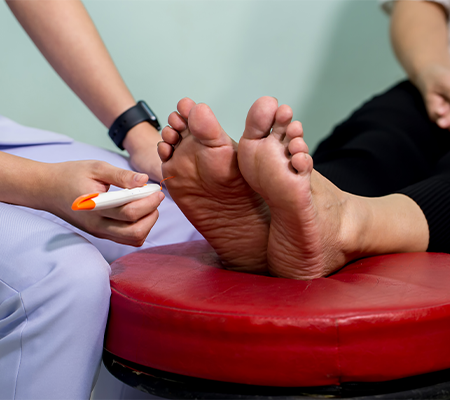
When a plantar fibroma causes pain in your foot, you might think your only option is surgery. However, with the help of your podiatrist, you can explore other treatments to help decrease your pain.
A plantar fibroma is a fibrous knot or mass on the arch of your foot. It grows on your plantar fascia, the rubber band-like ligament that stretches from your heel to your toes. It is noncancerous with no known cause, but it can develop because of repetitive trauma.
It may not be noticeable at first, but if plantar fibroma grows larger, it can cause discomfort, especially when you wear shoes. It’s time to visit your podiatrist when it changes in size, appearance or becomes more painful.
Treatment focuses on reducing pain
Many effective conservative treatment options don’t require surgery to help relieve pain. Methods include:
- Stretching
- Physical therapy
- Orthotic
- Injection therapy
“Options like stretching or physical therapy focus on that fibrous knot,” said Dr. Kerry Dernbach, Marshfield Clinic Health System podiatrist. “These approaches help reduce scar tissue, adhesions and reduce tension on plantar fascia to keep tissue more flexible.”
Dernbach encourages patients to work closely with their provider to discuss expectations and lifestyle to help them identify treatment options.
“Another unique option I can offer patients is a Vitrase injection, which can reduce pain,” Dernbach said.
Treatment focuses on pain reduction rather than removing the growth. People experience prolonged recovery times after surgery since incisions and scarring are at the bottom of foot. “Surgery can be successful, but it’s not necessarily right for all people based on their activity level,” Dernbach said. “We’ll look at other options to manage pain before exploring surgery.”
Plantar fasciitis vs. plantar fibroma
While the fibroma grows on the plantar fascia, you may not have traditional plantar fasciitis with a plantar fibroma. Plantar fasciitis is inflammation of the plantar fascia. It has many different causes including overuse, foot structure, trauma and inappropriate shoes. There is not the fibrous knot (nodule). The two can sometimes occur together.
Dr. Dernbach recommends seeking care when you see changes in your foot or if pain starts affecting the things you enjoy doing.
For questions about your feet, talk to a Marshfield Clinic Health System provider.
Find a Podiatry provider Learn more about Podiatry
Related Shine365 articles
A pain in my…heel? What you need to know about plantar fasciitis
Bunions: More than just a toe problem
How can you prevent a diabetic foot ulcer?






Leave a Reply